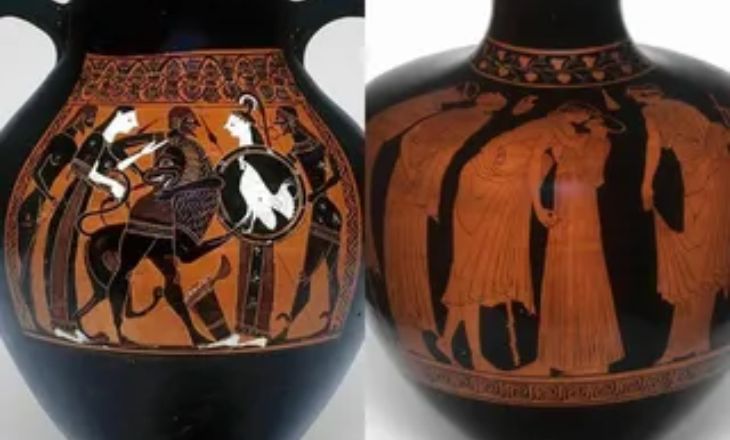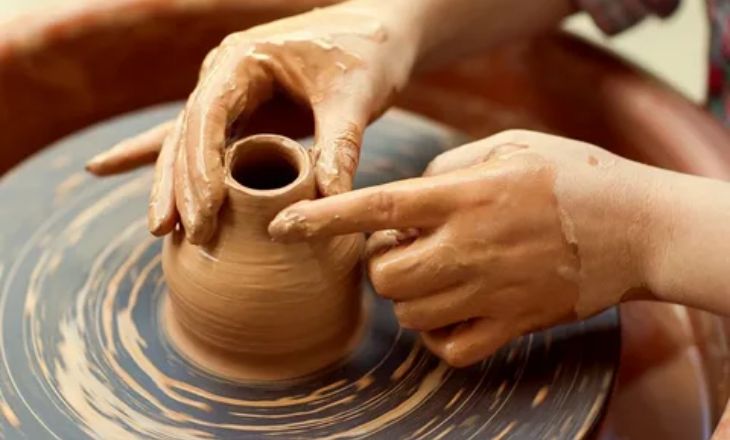Ancient Greek Black-Figure Pottery was a difficult and detailed art form that required high skill and care for detail. Shaping the clay into the right form for the clay container was the first step, and they were added. After applying a unique black slip on the pottery’s appearance, painters used small brushes to create complex designs.
What Is Black-Figure Pottery?
After heating the vessel, expert artists had to carefully shape complex themes and patterns into the clay to create Black Figure Pottery.

The works had a realistic depth that was unparalleled at the time due to the stark difference between the red clay backdrop and the shining black finish with its basic uses Black-Figure Pottery was important in ancient Greek worship, everyday life, and story themes.
Pottery Ideas exist choices are limitless, Black-figure pottery was a new technique in old Greek art that made it possible to press elaborate designs and texts onto the vase forms. If you’re a professional painter or just looking for fresh pottery ideas for painting.
This method uses slip and organic materials created on the pot’s surface to give earthenware life. Potters use each pot as a canvas on which to paint their stories, giving them historical significance in addition to aesthetic value.
Not only do the striking Black figure pottery silhouettes against the terracotta background serve as art, but they also educate and enthrall us about a long-gone society. Each piece of Black-Figure Pottery is a precious artifact a glimpse into our ancestors’ perspective.
What’s The Difference Between Red And Black-Figure Pottery?
When exploring the fascinating world of ancient Greek Ceramics, it’s hard to avoid becoming enthralled with the two well-known types that dominated this field for centuries: black- and red-figure pottery. The differences in the style switch to the uninitiated eye may seem fairly similar to how adaptable and forward-thinking our forebears’ creativity was.
The black-figure pottery style was painted with a glossy black slip, like a silhouette and predating its counterpart. The red-figure pottery painting style, which emerged later and is now more well-known, is thought to be an inverse version of its forerunner.

The Ancient Way Of Making A Black-Figure Vessel
The glossy black figure paint technique used to paint figures on ceramics dates back to the ancient Greek black-figure vase technique. When burnt in a kiln, the backdrop, which is left unpainted, turns crimson. This produces a noticeable contrast! Using this technique, artists shared scenes from everyday life and told stories.
Mining Clay
the arduous process of miners reaching shovelfuls of naturally existing Mining clay as they dig far down into the earth’s crust. This fundamental material, extracted from the center of Mother Nature herself, offers a fascinating viewpoint on this procedure. Mining Clay introduces us to an enthralling interplay between human ingenuity and pristine natural resources; it’s not just about extraction.
Outdoor pools provide a haven for these mixed elements, as they mingle under the purposeful moonlight or the watchful sun. A layer of cleansed clay was left behind as the water evaporated. To make the cleansed clay pliable, laborers had to knead it. Clay was now plastic and ready to be shaped into a vase.
Working On The Wheel
It’s like watching a private dance when you watch a potter working on the wheel. The potter’s worn hands dive into the middle of a harmless mound of clay with a gentle, confident touch. They create a depression in the center of it as though they are giving it a fresh pulse, a wake-up call to its potential.

The real magic happens when these deft hands lift up and outward, giving an inanimate mass life. The formerly amorphous blob takes on personality and purpose with each movement. It is like witnessing an uncut jewel being skillfully carved, with the rough edges polished over to reveal what has been buried and only needs the proper hands to bring out its inherent beauty.
Final Touches Before Decoration
We like to refer to as the Final Touches Before Decoration are highlighted by this complex process. It is the conclusion of formation and the start of decoration, acting as both a prelude and a finale. Under the watchful eye of its designer, the unspoiled stretches sparkle with promise, their naked porcelain façade exuding possibility. There’s an intriguing dichotomy here: the sections left unpainted aren’t a result of carelessness or oversight; rather, they’re a deliberate ‘encore’ used for decoration.
At this point, which is known as “Final Touches Before Decoration,” seemingly unrealized potential begins to emerge. Focusing on the off-white unpainted area, which is left as an untapped source of inspiration, causes the magic to happen. It’s the place where captivating artistic sparks ignite and grow into the captivating visual tales that are meant to be.
Decorating With The Black-Figure Technique
Artwork fans continue to be attracted to the black-figure method, which was first used in times past for covering pottery. Using a black color, people and scenes are inked onto clay pots using this age-old technique, creating a dramatic contrast with the pottery’s original color. Black-figure clay is one of the most unique types of Clay used in pottery-making; the ancient Greeks created this method.
The complex designs made possible by this method show a level of beauty and complexity that points to the skill of ancient artists. The ancient Greeks used Coil pottery, a technique that included shaping clay into long twists and stacked them on top of one another to make beautiful black-figure ceramics.
The task of transforming Greenware Ceramics into a result needs careful planning, skillful operation, and technical expertise. To create the famous black figure, painters would carefully paint Complex patterns using fine brushes and tools, then fire their work at high temperatures in a kiln.
The Method of Black-Figure
Our artist infuses life into their Ceramics by using charcoal, an exquisite sketching instrument. Beautiful maidens execute sacred rites in homage to ancient gods while flaming dragons engage in combat with mythical beasts under the competent supervision of these creatures.
These striking drawings contrast sharply with the earthy hue of the clay, but they are doomed to fade into shadows. Only when they have painted a glossy black color, which gives them persistence when burnt in the kiln later, do they become more than just ghosts.
It’s amazing how detailed details can emerge from such fleeting first sketches. This is the fundamental idea behind Decorating With The Black-Figure Technique The charcoal would then be used as a guide to add silhouetted figures with slip. The shapes were those of humans or animals.
FIRING THE CLAY – ANCIENT KILNS
Ancient kilns were sacred spaces where temperature-controlled time sculpting and realizing the vision of an artist. They were more than just buildings. Each result was distinct because of the extreme unpredictability of the firing process, producing masterpieces with flawless flaws.

These containers waited to be transformed in the center of the massive kiln. The tremendous heat would slowly dance around each vessel, transforming them from soft clay things into hardened ceramic articulations of human culture and creativity. The great pottery thrown down cast is an example of the power that humans have of mind and art to go beyond time and link us with our common past.
over six to eight days on average. These fragments would be enveloped in a flaming embrace by the glittering embers before being burnt and rendered eternally immortal by the passage of time inside these historic kilns. It took a great deal of skill and precision to fire something. Neither precise clocks nor thermometers were available back then. It sounds like a bad dream.
Heating The Kiln With Oxygen
The innovative technique used by skilled Greek potters to Heat the kiln with oxygen was far ahead of its time. Their invention of an advanced chamber system in the kilns which demonstrated a creative and remarkable grasp of chemistry was an interesting fact.
These chambers made it possible for air to circulate in particular kiln areas, producing an oxygen-rich atmosphere that was essential for preserving the high steady temperatures needed for pottery. This carefully planned release of oxygen changed the course of pottery making. The abundance of oxygen in the kiln not only regulated temperature but also affected the colors that were fired into the pottery, turning ordinary clay objects into amazing pieces of art.
Imagine these ancient Greek artisans getting together around the furnace, building a fire to warm their creations. They had no idea how important this technique would become to pottery all across the world, demonstrating once more how timeless Greek inventiveness is.
Increasing The Kiln Temperature And Removing Oxygen
The temperature inside the kiln rises significantly sending us on a journey through intense heat something like the molten core of a volcano. Not less than a scorching 1700 degrees. While baking may be all about maintaining composure under duress fanning flames to their greatest extent is what matters in the realm of Ceramics and Pottery.
Start the air intake vents are closed off to create a low-oxygen condition. the addition of moist wood or wet leaves, which are carefully positioned inside to increase the temperature even more and create steam that helps lower the oxidation potentials in the surrounding area. It isn’t as simple as one might believe to raise the kiln temperature and remove oxygen.
Painstakingly delicate craftsmanship, where passion and patience collide to create stunning jewels that are preserved by dynasties and are highly sought after.
Re-Introducing Oxygen Into The Kiln
We’ve found that reintroducing oxygen into the kiln is the key. An atmosphere rich in oxygen is produced by gradually introducing controlled amounts of air into the kiln’s upper chamber throughout the slow-rising heating stages.
This increased control creates opportunities for improved clay body transitions and novel glaze effects. It eliminates ingrained constraints and transforms current practices. This approach can significantly change our understanding of how ceramics are produced, as artists and engineers are always looking for new and innovative ways to create.
Every new technique used can reveal even more potential that has yet to be discovered. take a closer look at adding oxygen to our cherished kilns.
Conclusion
Black-figure pottery only grows in a time when instant happiness is valued highly. that these works of art were produced thousands of years ago almost seems disconcerting given how masterfully they combine beauty with utility. many things in today’s world are disposable and hardly appreciated for what they truly are.
Using a new process has made these works unique and famous in the context of ancient art. Their capacity to tell stories and record moments in history is proof of their creative ability. We will keep respecting and researching these resources to protect the rich history of our parents.
FAQs
What Makes Black Figure Pottery Unique?
The unique decorative technique of black-figure pottery, which paints images in black slip-on red clay in the background, makes it unique. The images stood out because of the graphically startling contrasts produced by the technique’s capacity to capture tiny details and clear lines.
Who Is A Famous Black Ceramic Artist?
Roberto Lugo is a well-known black ceramicist who is known for his unique blend of age-old pottery skills with modern themes and commentary on society.
